Regional and Seasonal Dynamics of Heavy Metal Accumulation in Saudi Dromedary Camel Serum and Milk as Bioindicators of Environmental Quality
Abstract
1. Introduction
2. Materials and Methods
2.1. Ethical Approval
2.2. Study Area and Climatic Conditions
2.3. Environmental Sample Collection
2.4. Handling and Preservation of Biological Samples
2.5. Sample Digestion Procedure
2.6. Mineral Analysis by ICP–OES
2.7. Statistical Analysis
3. Results
3.1. Soil, Water, and Feed Heavy Metals
3.2. Serum Heavy Metals
3.3. Milk Heavy Metals
3.4. Correlation Analysis
4. Discussion
5. Conclusions
Author Contributions
Funding
Institutional Review Board Statement
Informed Consent Statement
Data Availability Statement
Acknowledgments
Conflicts of Interest
References
- Tchounwou, P.B.; Yedjou, C.G.; Patlolla, A.K.; Sutton, D.J. Heavy metal toxicity and the environment. In Molecular, Clinical and Environmental Toxicology: Volume 3: Environmental Toxicology; Springer: Basel, Switzerland, 2012; Volume 101, pp. 133–164. [Google Scholar]
- Jadaa, W.; Mohammed, H. Heavy metals–definition, natural and anthropogenic sources of releasing into ecosystems, toxicity, and removal methods–an overview study. J. Ecol. Eng. 2023, 24, 249–271. [Google Scholar] [CrossRef] [PubMed]
- Maglas, N.N.; Turki, S.A.; Qiang, Z.; Ali, M.M.; Osta, A.A.; Alwarqi, M.S.; Najar, M. Assessment of radioactive nuclides and heavy metals in soil and drink water in lahij city, yemen. Appl. Radiat. Isot. 2025, 215, 111566. [Google Scholar] [CrossRef] [PubMed]
- Jaishankar, M.; Tseten, T.; Anbalagan, N.; Mathew, B.B.; Beeregowda, K.N. Toxicity, mechanism and health effects of some heavy metals. Interdiscip. Toxicol. 2014, 7, 60. [Google Scholar] [CrossRef] [PubMed]
- Bobojonov, K.S.; Umataliyevna, U.K.; Asanaliyevna, S.Z.; Muxsimovna, A.M.; Mamadjanovna, T.F.; Shavkatovna, A.M.; G’ulom o’gli, A.U.B.; Abdujalol o’g’li, G.A. Priority toxic metals arsenic, cadmium, mercury, and lead in ecosystems: A review of sources, toxicity, and regulatory approaches. Chem. Rev. Lett. 2025, 8, 883–902. [Google Scholar]
- Generalova, A.; Davidova, S.; Satchanska, G. The mechanisms of lead toxicity in living organisms. J. Xenobiotics 2025, 15, 146. [Google Scholar] [CrossRef]
- Ghribi, F.; Bejaoui, S.; Chetoui, I.; Trabelsi, W.; Belhassen, D.; Ben Fayala, C.; Boubaker, S.; Mili, S.; Soudani, N. Toxicological effects of cobalt on common carp: Oxidative stress, ionic imbalance, fatty acid disruption, and gill histopathology. Environ. Geochem. Health 2025, 47, 98. [Google Scholar] [CrossRef]
- Alloway, B.J. Heavy Metals in Soils: Trace Metals and Metalloids in Soils and Their Bioavailability; Springer Science & Business Media: Berlin/Heidelberg, Germany, 2012. [Google Scholar]
- Di Bella, G.; El-Sorogy, A.S.; Giacobbe, S.; Nava, V.; Al-Kahtany, K.; Nour, H.E. Risk assessment of potentially toxic elements in intermittent rivers, “fiumara”, flowing in the gulf of milazzo (Sicily, Italy). Environ. Earth Sci. 2024, 83, 321. [Google Scholar] [CrossRef]
- Abdulaziz, M.; Alshehri, A.; Yadav, I.C.; Badri, H. Pollution level and health risk assessment of heavy metals in ambient air and surface dust from saudi arabia: A systematic review and meta-analysis. Air Qual. Atmos. Health 2022, 15, 799–810. [Google Scholar] [CrossRef]
- Gantayat, R.R.; Elumalai, V. Salinity-induced changes in heavy metal behavior and mobility in semi-arid coastal aquifers: A comprehensive review. Water 2024, 16, 1052. [Google Scholar] [CrossRef]
- El Kenawy, A.M. Hydroclimatic extremes in arid and semi-arid regions: Status, challenges, and future outlook. In Hydroclimatic Extremes in the Middle East and North Africa; Elsevier: Amsterdam, The Netherlands, 2024; pp. 1–22. [Google Scholar]
- Ajarem, J.S.; Hegazy, A.K.; Allam, G.A.; Allam, A.A.; Maodaa, S.N.; Mahmoud, A.M. Heavy metal accumulation, tissue injury, oxidative stress, and inflammation in dromedary camels living near petroleum industry sites in saudi arabia. Animals 2022, 12, 707. [Google Scholar] [CrossRef]
- Alharbi, T.; Nour, H.E.; Al-Kahtany, K.; Zumlot, T.; El-Sorogy, A.S. Health risk assessment and contamination of lead and cadmium levels in sediments of the northwestern arabian gulf coast. Heliyon 2024, 10, e36447. [Google Scholar] [CrossRef] [PubMed]
- Abdelrahman, M.M.; Alhidary, I.A.; Alobre, M.M.; Matar, A.M.; Al-Badwi, M.A.; Qaid, M.M.; Aljumaah, R.S. Trace elements levels in growing camels’(camelus dromedarius) biological tissues from semi-arid areas. J. Appl. Anim. Res. 2025, 53, 2452506. [Google Scholar] [CrossRef]
- Abdelrahman, M.M.; Alhidary, I.A.; Alobre, M.M.; Matar, A.M.; Alharthi, A.S.; Faye, B.; Aljumaah, R.S. Regional and seasonal variability of mineral patterns in some organs of slaughtered one-humped camels [Camelus dromedarius] from saudi arabia. Animals 2022, 12, 3343. [Google Scholar] [CrossRef] [PubMed]
- Ullah, S.; Ennab, W.; Wei, Q.; Wang, C.; Quddus, A.; Mustafa, S.; Hadi, T.; Mao, D.; Shi, F. Impact of cadmium and lead exposure on camel testicular function: Environmental contamination and reproductive health. Animals 2023, 13, 2302. [Google Scholar] [CrossRef]
- Mustapha, A.; Zainab, K.R.; Musa, H. Determination of heavy metals in some organs of ruminants slaughtered at funtua central abattoir, katsina state, nigeria. Niger. J. Anim. Sci. Technol. NJAST 2025, 8, 125–135. [Google Scholar]
- Al-Kahtany, K.; El-Sorogy, A.S.; Alharbi, T. Ecological risk assessment and potential source of as, cd, co, and ni in al qunfudhah seawater, red sea coast, saudi arabia. J. King Saud Univ.-Sci. 2024, 36, 103560. [Google Scholar] [CrossRef]
- El-Sorogy, A.S.; Nour, H.E.; Al-Kahtany, K.; Youssef, M.; Alharbi, T.; Yakubu, M.A. Potential health and ecological risk assessment of selected heavy metals in dammam coastal sediments, arabian gulf. Reg. Stud. Mar. Sci. 2025, 89, 104354. [Google Scholar] [CrossRef]
- Nazzal, Y.; Bărbulescu, A.; Sharma, M.; Howari, F.; Ben Salem, I.; Dghaim, R.; Kumbhar, P.; Xavier, C.M.; Alghafli, S.; Al-Taani, A.A.; et al. Heavy metal pollution in arid urban environments: Anthropogenic and geogenic insights from road dust in the united arab emirates. Arch. Environ. Contam. Toxicol. 2025, 89, 313–334. [Google Scholar] [CrossRef]
- Abdelrahman, M.M.; Alhidary, I.A.; Aljumaah, R.S.; Faye, B. Blood trace element status in camels: A review. Animals 2022, 12, 2116. [Google Scholar] [CrossRef]
- Ayyat, M.S.; Monem, U.M.A.; Mostafa, T.H.; Thabet, R.M.; El-Latif, K.M.A.; Al-Sagheer, A.A. Influence of long-term dietary cobalt supplementation on lactation performance and reproductive efficiency in maghrabi she-camels. Biol. Trace Elem. Res. 2025, 203, 5183–5194. [Google Scholar] [CrossRef]
- Genchi, G.; Lauria, G.; Catalano, A.; Carocci, A.; Sinicropi, M.S. Prevalence of cobalt in the environment and its role in biological processes. Biology 2023, 12, 1335. [Google Scholar] [CrossRef] [PubMed]
- Bouida, L.; Rafatullah, M.; Kerrouche, A.; Qutob, M.; Alosaimi, A.M.; Alorfi, H.S.; Hussein, M.A. A review on cadmium and lead contamination: Sources, fate, mechanism, health effects and remediation methods. Water 2022, 14, 3432. [Google Scholar] [CrossRef]
- Alghamdi, A.G.; El-Saeid, M.H.; Alzahrani, A.J.; Ibrahim, H.M. Heavy metal pollution and associated health risk assessment of urban dust in riyadh, saudi arabia. PLoS ONE 2022, 17, e0261957. [Google Scholar] [CrossRef] [PubMed]
- Kuznietsov, P.; Biedunkova, O. Application of multivariate statistical techniques for assessing spatiotemporal variations of heavy metal pollution in freshwater ecosystems. Water Conserv. Sci. Eng. 2025, 10, 13. [Google Scholar] [CrossRef]
- Afzal, A.; Mahreen, N. Emerging insights into the impacts of heavy metals exposure on health, reproductive and productive performance of livestock. Front. Pharmacol. 2024, 15, 1375137. [Google Scholar] [CrossRef]
- Farooq, M.; Saleem, M.; Yap, C.; Zaib, M.; Khan, Q.; Ibrahim, M.; Sakandar, H. Estimation of heavy metals in milk of different areas of sialkot (pakistan) and its possible health impact on consumer. J. Food Qual. Hazards Control 2025, 12, 210–217. [Google Scholar] [CrossRef]
- Souto, M.R.S.; Pimenta, A.M.; Catarino, R.I.L.; Leal, M.F.C.; Simões, E.T.R. Heavy metals in milk and dairy products: Safety and analysis. Pollutants 2025, 5, 29. [Google Scholar] [CrossRef]
- Fatima, G.; Raza, A.M.; Dhole, P. Heavy metal exposure and its health implications: A comprehensive review. Indian J. Clin. Biochem. 2025, 1–29. [Google Scholar] [CrossRef]
- Jomova, K.; Alomar, S.Y.; Nepovimova, E.; Kuca, K.; Valko, M. Heavy metals: Toxicity and human health effects. Arch. Toxicol. 2025, 99, 153–209. [Google Scholar] [CrossRef]
- Codex Stan 193-1995; Codex General Standard for Contaminants and Toxins in Food and Feed. FAO: Rome, Italy, 2024.
- Al Nadhairi, R.; Al Kalbani, M.; Al Khazami, S.; Al Hashmi, M.; Al Zadai, S.; Al-Rumhi, Y.; Al-Kindi, K.M. Air quality and health risk assessment during middle eastern dust storms: A study of particulate matter. Air Qual. Atmos. Health 2025, 18, 587–603. [Google Scholar] [CrossRef]
- Budakoti, S.; Singh, C.; Choudhury, A. Transport of a severe dust storm from middle east to indian region and its impact on surrounding environment. Int. J. Environ. Sci. Technol. 2023, 20, 10345–10366. [Google Scholar] [CrossRef]
- Almotairy, H.M.; Alshehri, K.A.; Almutairi, O.A.; Alenizi, H.O.; Bokheder, S. Enhancing agricultural biosecurity: Strategies for food safety and environmental sustainability in saudi arabia. In Worldwide Megatrends in Food Safety and Food Security; IntechOpen: London, UK, 2024. [Google Scholar] [CrossRef]
- Almulhim, A.I. Toward a greener future: Applying circular economy principles to saudi arabia’s food sector for environmental sustainability. Sustainability 2024, 16, 786. [Google Scholar] [CrossRef]
- Alharthi, S.; Alharthi, A.; Alharthi, M. Sustainable development goals in the kingdom of saudi arabia’s 2030 vision. Sustain. City XIII 2019, 238, 455. [Google Scholar]
- Altouma, A.; Bashir, B.; Ata, B.; Ocwa, A.; Alsalman, A.; Harsányi, E.; Mohammed, S. An environmental impact assessment of saudi arabia’s vision 2030 for sustainable urban development: A policy perspective on greenhouse gas emissions. Environ. Sustain. Indic. 2024, 21, 100323. [Google Scholar] [CrossRef]
- Alshuwaikhat, H.M.; Mohammed, I. Sustainability matters in national development visions—Evidence from saudi arabia’s vision for 2030. Sustainability 2017, 9, 408. [Google Scholar] [CrossRef]
- Chemists. AOAC: Official Methods of Analysis, 20th ed.; Latimer, G.W., Ed.; AOAC International: Washington, DC, USA, 2016. [Google Scholar]
- Harris, A.; Xanthos, S.J.; Galiotos, J.K.; Douvris, C. Investigation of the metal content of sediments around the historically polluted potomac river basin in washington dc, united states by inductively coupled plasma-optical emission spectroscopy (icp-oes). Microchem. J. 2018, 142, 140–143. [Google Scholar] [CrossRef]
- Gazzawi, B.; Qadah, D.; Mubiana, V.K.; Bervoets, L.; Al Zabadi, H.; Blust, R. Exposure assessment of as, cd, hg, and pb in fish and canned fish collected from local markets at ramallah city using high-resolution inductively coupled plasma mass spectrometry. Front. Sustain. Food Syst. 2025, 9, 1591035. [Google Scholar] [CrossRef]
- Häßler, M.; Wetzel, K.; Warnecke, L.; Niedenthal, T.; Montero, L.; Ayala-Cabrera, J.F.; Schmitz, O.J. Assessment of the differentiation of sambucus nigra plant parts using a multi-target and suspect screening by lc-hrms and icp-oes. Anal. Bioanal. Chem. 2025, 417, 6209–6220. [Google Scholar] [CrossRef]
- Faye, B. Camel. In Encyclopedia of Dairy Sciences; Elsevier: Amsterdam, The Netherlands, 2022. [Google Scholar]
- Khan, Z.I.; Liu, W.; Mubeen, I.; Alrefaei, A.F.; Alharbi, S.N.; Muhammad, F.G.; Ejaz, A.; Ahmad, K.; Nadeem, M.; Shoukat, J.; et al. Cobalt availability in the soil plant and animal food chain: A study under a peri-urban environment. Braz. J. Biol. 2023, 83, e270256. [Google Scholar] [CrossRef]
- Abdou, A.; Mohamed, F. Estimation of some heavy metals residues in blood serum and tissues of camels. Assiut Vet. Med. J. 2015, 61, 221–229. [Google Scholar]
- Abdelrahman, M.M.; Alhidary, I.A.; Matar, A.M.; Alobre, M.M.; Ayadi, M.; Aljumaah, R.S. Heavy metals levels in soil, water and feed and relation to slaughtered camels’ tissues (Camelus dromedarius) from five districts in saudi arabia during spring. Life 2023, 13, 732. [Google Scholar] [CrossRef] [PubMed]
- Mohamed, W.H.; Sherkawy, H.S.; Mohamed, R.H.; Noseer, E.A. Assessment of trace elements and metals status in imported camels. J. Adv. Vet. Res. 2024, 14, 113–116. [Google Scholar]
- Meligy, A.; Ghareeb, W.; Raheem, S.; Ismail, H.; Darwish, W.; Kandeel, M.; Alfifi, A.; Shokair, S.; Hussein, M. Assessment of some toxic elements (co, cr, mn, se, and as) in muscle, offal, hair, and blood of camels (Camelus dromedaries) and their risk assessment. Open Vet. J. 2024, 14, 154. [Google Scholar] [CrossRef]
- Acosta-Dacal, A.; Henríquez, A.M.; Corbera, J.A.; Macías-Montes, A.; Zumbado, M.; Ruiz-Suárez, N.; Martín-Barrasa, J.L.; Luzardo, O.P.; Tejedor-Junco, M.T. Comprehensive profiling of essential elements and organic and inorganic contaminants in dromedary camels from the canary islands: A baseline for nutritional and environmental assessment. Vet. Sci. 2025, 12, 829. [Google Scholar] [CrossRef]
- Zakaria, A.M.; Amin, Y.A.; Zakaria, H.M.; Farrag, F.; Fericean, L.; Banatean-Dunea, I.; Abdo, M.; Hafez, A.; Mohamed, R.H. Impact of grazing around industrial areas on milk heavy metals contamination and reproductive ovarian hormones of she-camel with assessment of some technological processes on reduction of toxic residue concentrations. BMC Vet. Res. 2024, 20, 34. [Google Scholar] [CrossRef]
- Kerdoun, M.A.; Djafer, R. Heavy metal levels in camel milk and health risk assessment: A global systematic review. J. Trace Elem. Miner. 2024, 8, 100131. [Google Scholar] [CrossRef]
- Ibrahim, M.S.I.; Hafez, A.-E.E.; El Bayomi, R.M.; Mahmoud, A.F.A. Review on camel meat: Health benefits, chemical contaminants, health risks, and mitigation strategies. Egypt. J. Vet. Sci. 2025, 56, 515–526. [Google Scholar] [CrossRef]
- Elafify, M.; El-Toukhy, M.; Sallam, K.I.; Sadoma, N.M.; Abd-Elghany, S.M.; Abdelkhalek, A.; El-Baz, A.H. Heavy metal residues in milk and some dairy products with insight into their health risk assessment and the role of lactobacillus rhamnosus in reducing the lead and cadmium load in cheese. Food Chem. Adv. 2023, 2, 100261. [Google Scholar] [CrossRef]
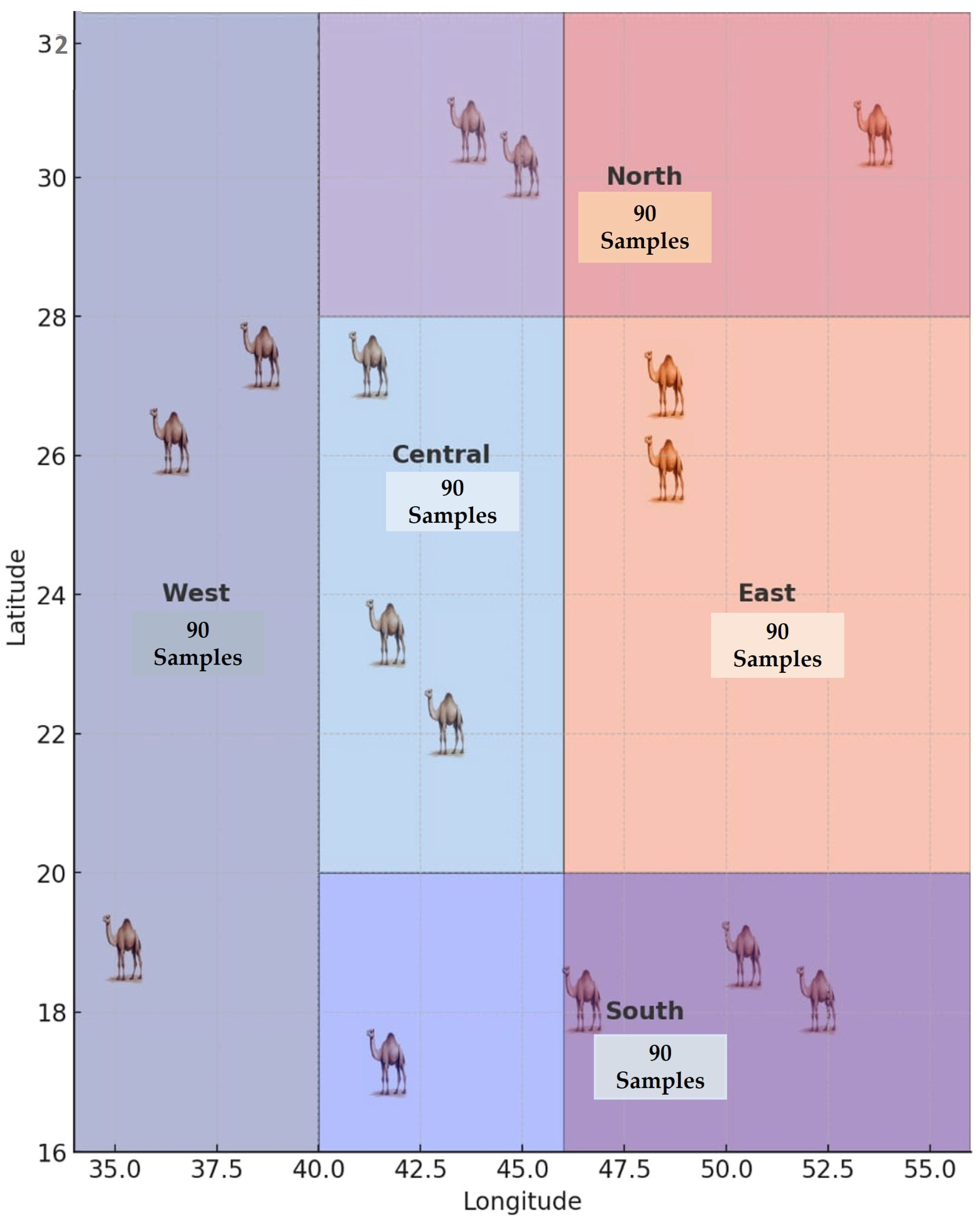

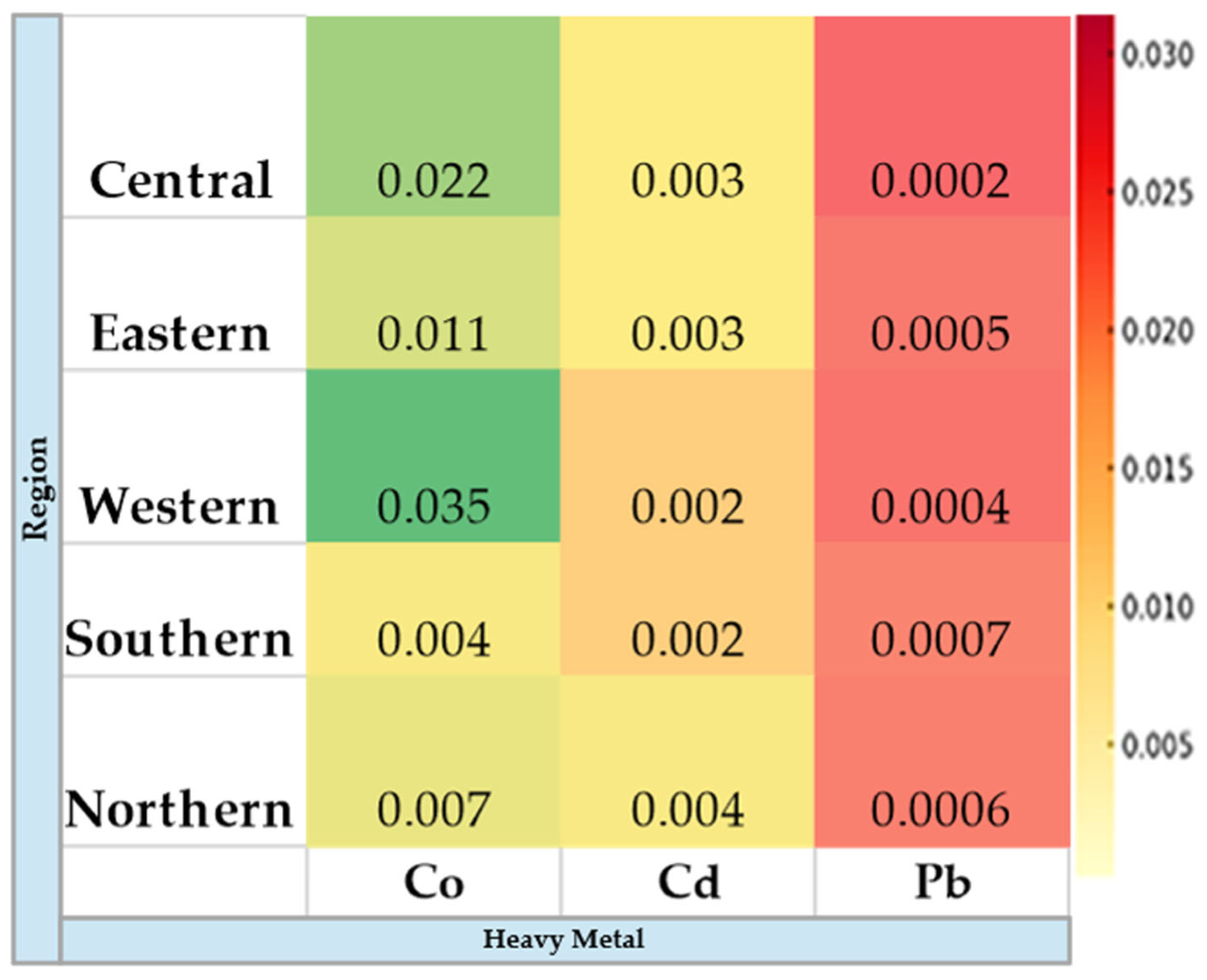
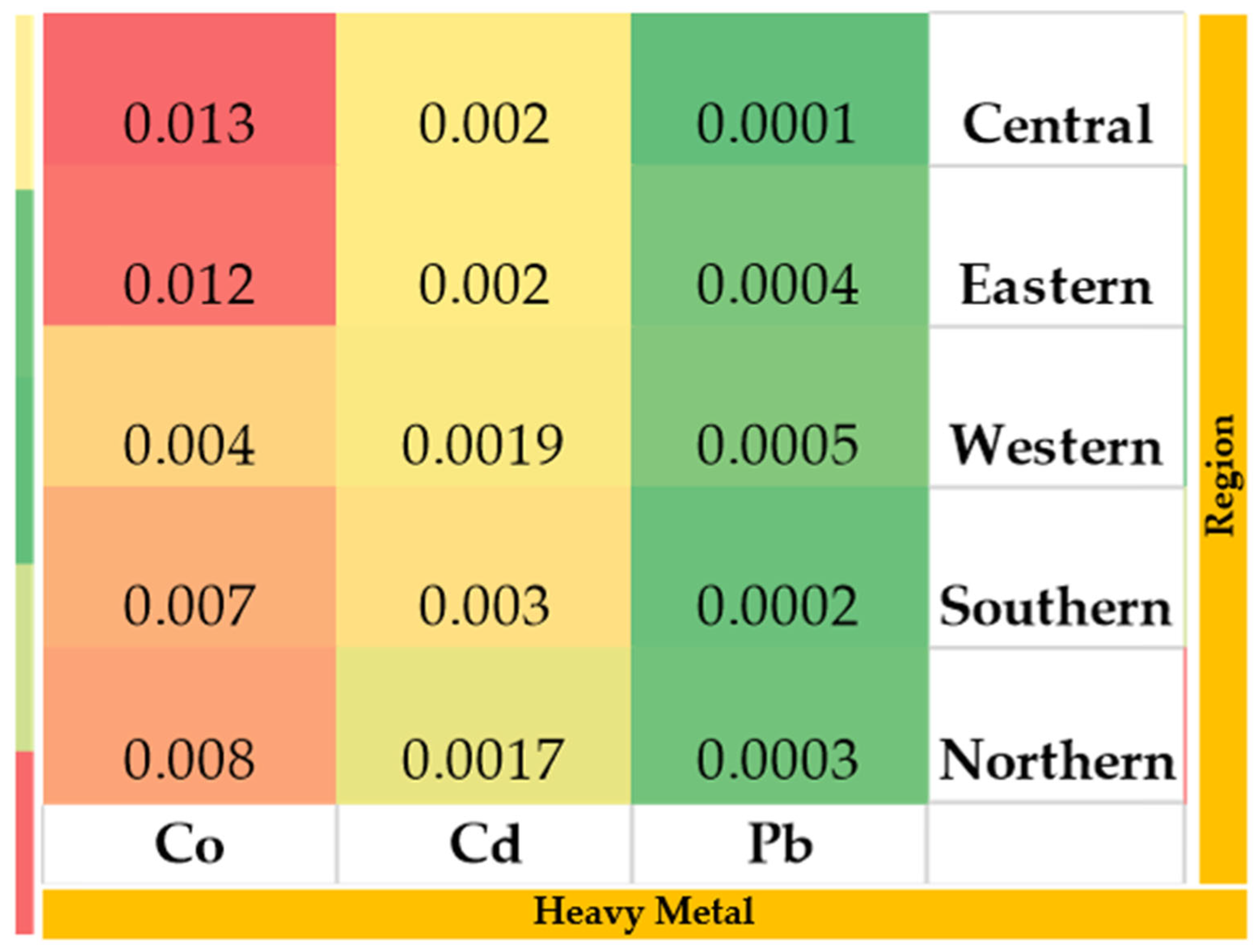
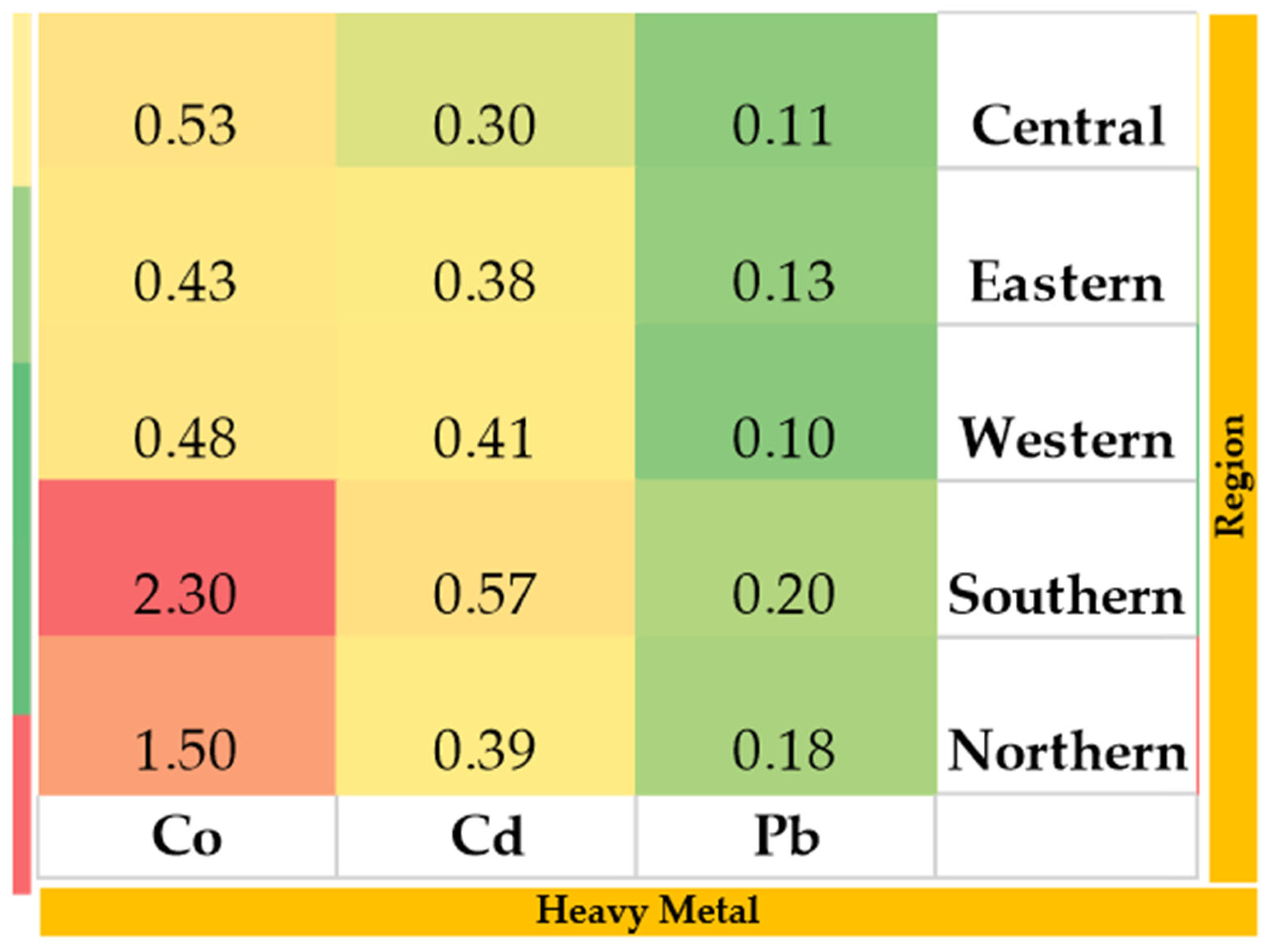

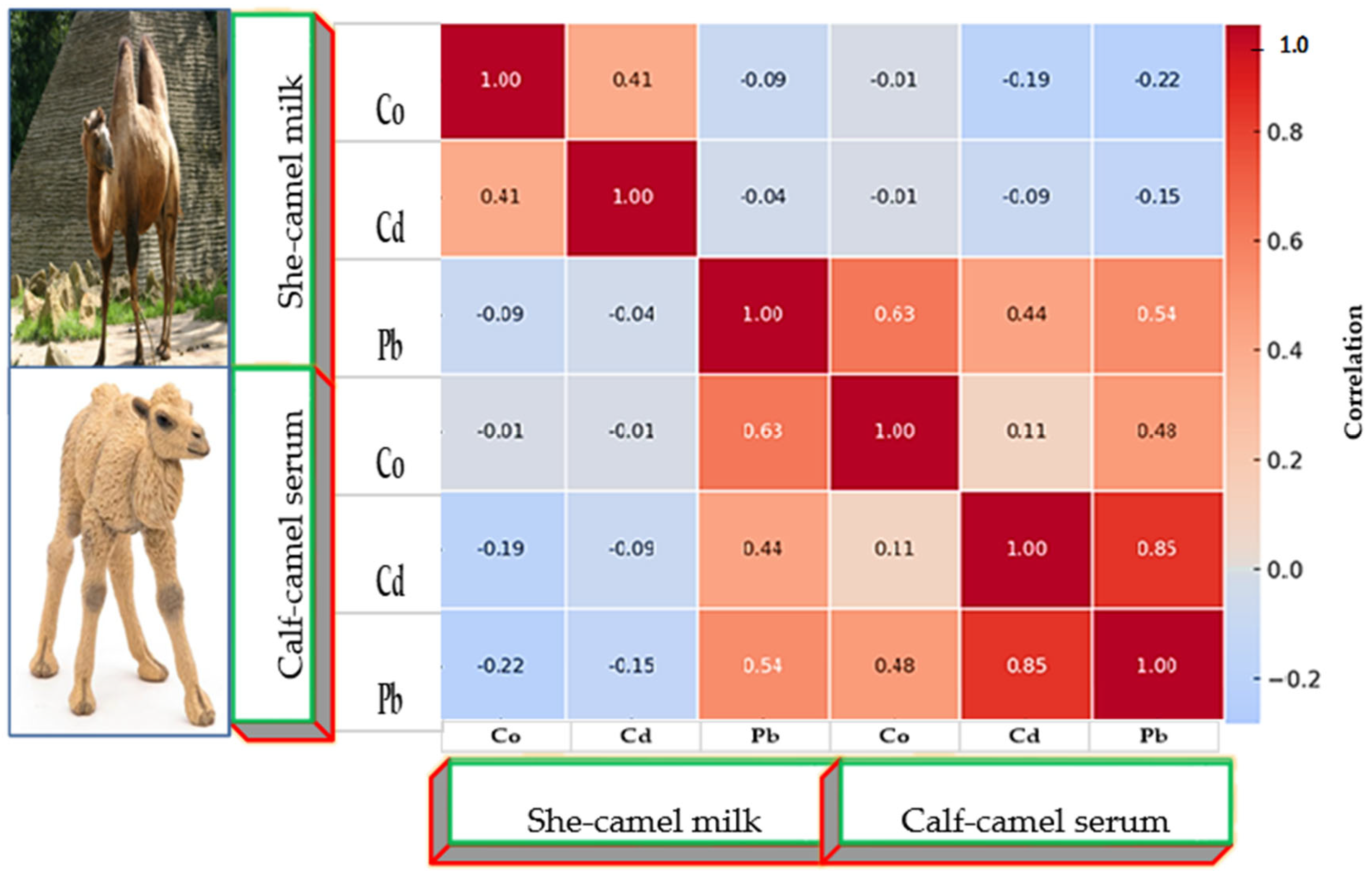
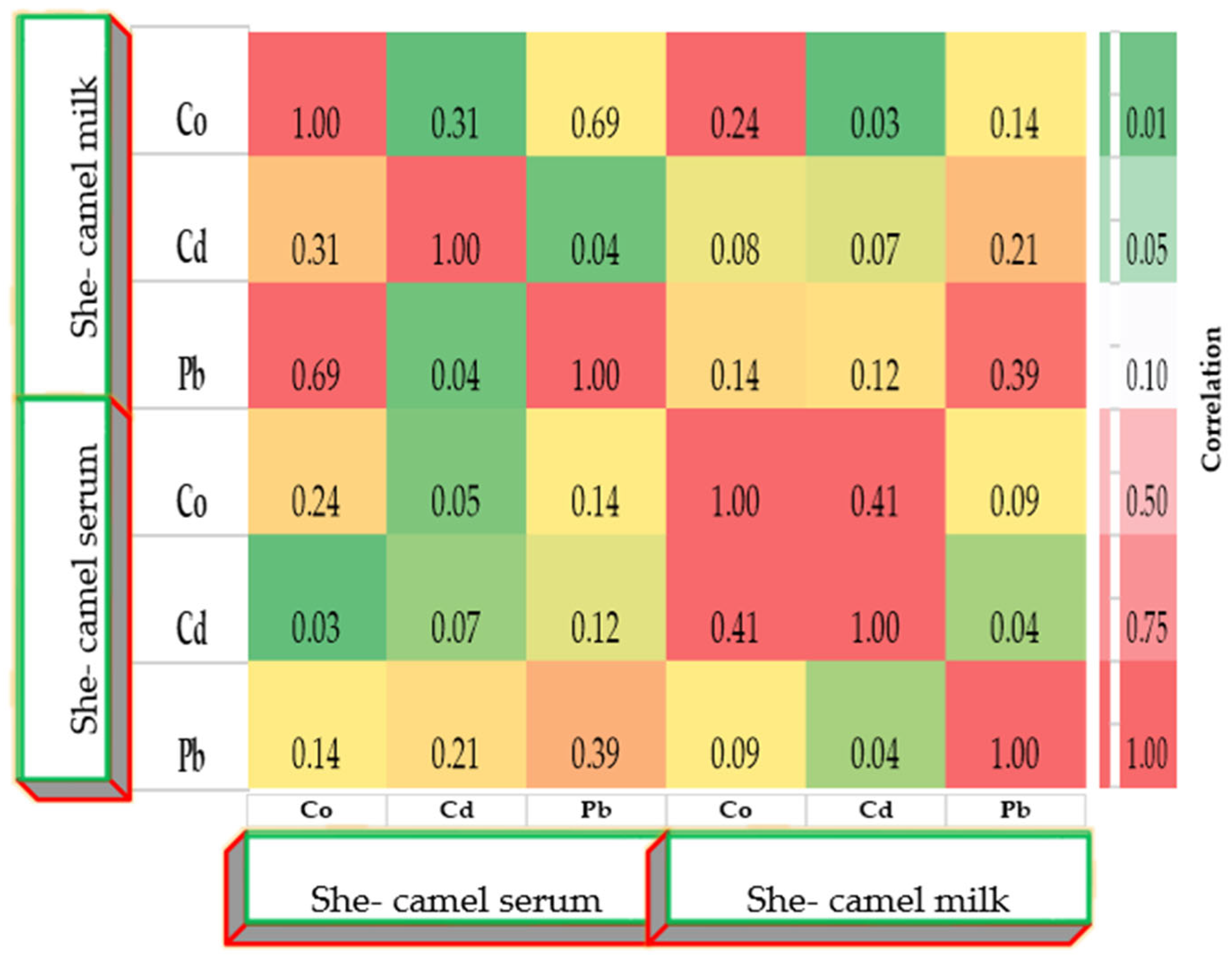
| Heavy Metals | Regions | SEM | p-Value | ||||
|---|---|---|---|---|---|---|---|
| Central | Eastern | Western | Southern | Northern | |||
| She-camel | |||||||
| Co | 0.012 b | 0.014 a | 0.014 a | 0.013 ab | 0.014 a | 0.001 | 0.022 |
| Cd | 0.024 ab | 0.021 b | 0.022 b | 0.026 a | 0.022 b | 0.001 | 0.001 |
| Pb | 0.006 | 0.007 | 0.009 | 0.007 | 0.006 | 0.001 | 0.666 |
| Calf camel | |||||||
| Co | 0.012 b | 0.015 a | 0.013 ab | 0.012 b | 0.012 b | 0.001 | 0.050 |
| Cd | 0.026 | 0.022 | 0.036 | 0.023 | 0.023 | 0.012 | 0.434 |
| Pb | 0.008 | 0.008 | 0.012 | 0.007 | 0.007 | 0.005 | 0.451 |
| Heavy Metals | Season | SEM | p-Value | ||
|---|---|---|---|---|---|
| Summer | Winter | Spring | |||
| She-camel | |||||
| Co | 0.012 b | 0.012 b | 0.015 a | 0.001 | 0.008 |
| Cd | 0.023 | 0.022 | 0.023 | 0.001 | 0.717 |
| Pb | 0.005 b | 0.006 b | 0.009 a | 0.001 | 0.003 |
| Calf camel | |||||
| Co | 0.013 b | 0.012 b | 0.015 a | 0.001 | 0.050 |
| Cd | 0.031 | 0.023 | 0.024 | 0.008 | 0.981 |
| Pb | 0.009 | 0.006 | 0.011 | 0.003 | 0.581 |
| Regions | Heavy Metals | Seasons | SEM | p-Value | ||
|---|---|---|---|---|---|---|
| Summer | Winter | Spring | Interaction | |||
| Central | 0.011 | 0.012 | 0.012 | |||
| Eastern | 0.014 | 0.012 | 0.014 | |||
| Western | 0.012 | 0.013 | 0.016 | |||
| Southern | 0.013 | 0.013 | 0.015 | |||
| Northern | Co | 0.012 | 0.013 | 0.015 | 0.001 | 0.271 |
| Central | 0.025 a | 0.023 b | 0.023 b | |||
| Eastern | 0.023 a | 0.020 b | 0.019 b | |||
| Western | 0.022 b | 0.023 ab | 0.025 a | |||
| Southern | 0.025 b | 0.027 a | 0.027 a | |||
| Northern | Cd | 0.020 b | 0.024 a | 0.024 a | 0.001 | 0.017 |
| Central | 0.004 | 0.006 | 0.009 | |||
| Eastern | 0.006 | 0.007 | 0.009 | |||
| Western | 0.007 | 0.007 | 0.014 | |||
| Southern | 0.006 | 0.006 | 0.009 | |||
| Northern | Pb | 0.006 | 0.007 | 0.007 | 0.001 | 0.622 |
| Regions | Heavy Metals | Seasons | SEM | p-Value | ||
|---|---|---|---|---|---|---|
| Summer | Winter | Spring | Interaction | |||
| Central | 0.011 | 0.013 | 0.017 | |||
| Eastern | 0.014 | 0.014 | 0.016 | |||
| Western | 0.014 | 0.013 | 0.015 | |||
| Southern | 0.014 | 0.012 | 0.014 | |||
| Northern | Co | 0.012 | 0.012 | 0.013 | 0.001 | 0.563 |
| Central | 0.026 | 0.025 | 0.028 | |||
| Eastern | 0.023 | 0.021 | 0.023 | |||
| Western | 0.059 | 0.024 | 0.024 | |||
| Southern | 0.025 | 0.022 | 0.022 | |||
| Northern | Cd | 0.022 | 0.025 | 0.024 | 0.013 | 0.981 |
| Central | 0.004 | 0.007 | 0.013 | |||
| Eastern | 0.006 | 0.008 | 0.011 | |||
| Western | 0.023 | 0.006 | 0.008 | |||
| Southern | 0.006 | 0.006 | 0.01 | |||
| Northern | Pb | 0.007 | 0.005 | 0.01 | 0.005 | 0.939 |
| Main Effects | Heavy Metals | ||
|---|---|---|---|
| Co | Cd | Pb | |
| Regions | |||
| Central | 0.387 | 0.051 | 0.408 ab |
| Eastern | 1.056 | 0.046 | 0.315 b |
| Western | 0.851 | 0.076 | 0.543 a |
| Southern | 0.819 | 0.066 | 0.269 b |
| Northern | 0.479 | 0.071 | 0.128 c |
| SEM | 0.383 | 0.012 | 0.067 |
| p-value | 0.414 | 0.202 | 0.008 |
| Seasons | |||
| Summer | 0.825 | 0.059 | 0.354 ab |
| Winter | 0.554 | 0.062 | 0.225 b |
| Spring | 0.619 | 0.059 | 0.445 a |
| SEM | 0.005 | 0.161 | 0.049 |
| p-value | 0.682 | 0.944 | 0.042 |
| Regions | Heavy Metals | Seasons | SEM | p-Value | ||
|---|---|---|---|---|---|---|
| Summer | Winter | Spring | Interaction | |||
| Central | 0.289 | 0.442 | 0.299 | |||
| Eastern | 3.813 a | 0.344 b | 0.408 b | |||
| Western | 0.261 b | 2.439 a | 0.150 b | |||
| Southern | 0.319 b | 0.492 b | 1.698 a | |||
| Northern | Co | 0.452 | 0.495 | 0.387 | 0.011 | <0.0001 |
| Central | 0.042 | 0.049 | 0.074 | |||
| Eastern | 0.056 | 0.037 | 0.056 | |||
| Western | 0.047 b | 0.194 a | 0.028 b | |||
| Southern | 0.101 a | 0.045 b | 0.066 b | |||
| Northern | Cd | 0.042 | 0.07 | 0.082 | 0.187 | <0.0001 |
| Central | 0.185 b | 0.296 b | 0.966 a | |||
| Eastern | 0.388 | 0.204 | 0.354 | |||
| Western | 0.66 | 0.392 | 0.579 | |||
| Southern | 0.248 | 0.339 | 0.127 | |||
| Northern | Pb | 0.412 | 0.126 | 0.137 | 0.058 | 0.008 |
Disclaimer/Publisher’s Note: The statements, opinions and data contained in all publications are solely those of the individual author(s) and contributor(s) and not of MDPI and/or the editor(s). MDPI and/or the editor(s) disclaim responsibility for any injury to people or property resulting from any ideas, methods, instructions or products referred to in the content. |
© 2025 by the authors. Licensee MDPI, Basel, Switzerland. This article is an open access article distributed under the terms and conditions of the Creative Commons Attribution (CC BY) license (https://creativecommons.org/licenses/by/4.0/).
Share and Cite
Abdelrahman, M.M.; Alobre, M.M.; Qaid, M.M.; Al-Badwi, M.A.; Matar, A.M.; Aboragah, A.A.; Amran, R.A.; Aljumaah, R.S. Regional and Seasonal Dynamics of Heavy Metal Accumulation in Saudi Dromedary Camel Serum and Milk as Bioindicators of Environmental Quality. Sustainability 2025, 17, 10205. https://doi.org/10.3390/su172210205
Abdelrahman MM, Alobre MM, Qaid MM, Al-Badwi MA, Matar AM, Aboragah AA, Amran RA, Aljumaah RS. Regional and Seasonal Dynamics of Heavy Metal Accumulation in Saudi Dromedary Camel Serum and Milk as Bioindicators of Environmental Quality. Sustainability. 2025; 17(22):10205. https://doi.org/10.3390/su172210205
Chicago/Turabian StyleAbdelrahman, Mutassim M., Mohsen M. Alobre, Mohammed M. Qaid, Mohammed A. Al-Badwi, Abdulkareem M. Matar, Ahmad A. Aboragah, Ramzi A. Amran, and Riyadh S. Aljumaah. 2025. "Regional and Seasonal Dynamics of Heavy Metal Accumulation in Saudi Dromedary Camel Serum and Milk as Bioindicators of Environmental Quality" Sustainability 17, no. 22: 10205. https://doi.org/10.3390/su172210205
APA StyleAbdelrahman, M. M., Alobre, M. M., Qaid, M. M., Al-Badwi, M. A., Matar, A. M., Aboragah, A. A., Amran, R. A., & Aljumaah, R. S. (2025). Regional and Seasonal Dynamics of Heavy Metal Accumulation in Saudi Dromedary Camel Serum and Milk as Bioindicators of Environmental Quality. Sustainability, 17(22), 10205. https://doi.org/10.3390/su172210205









